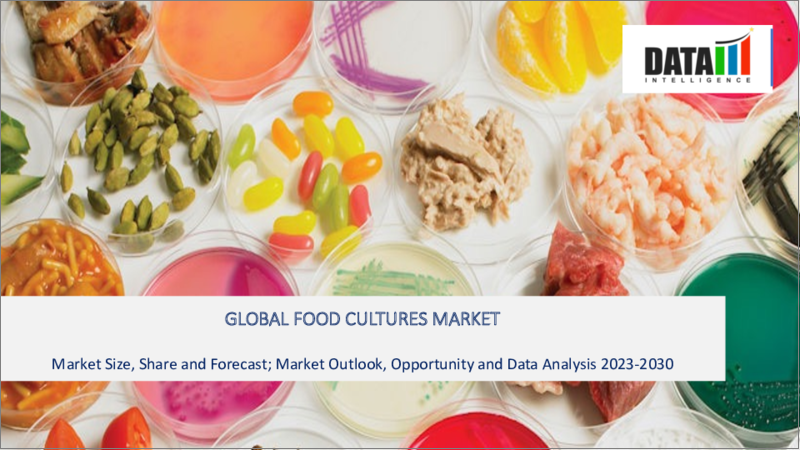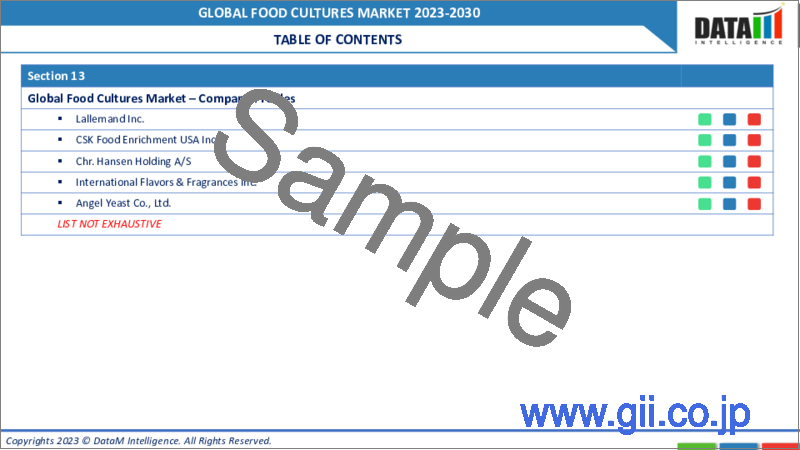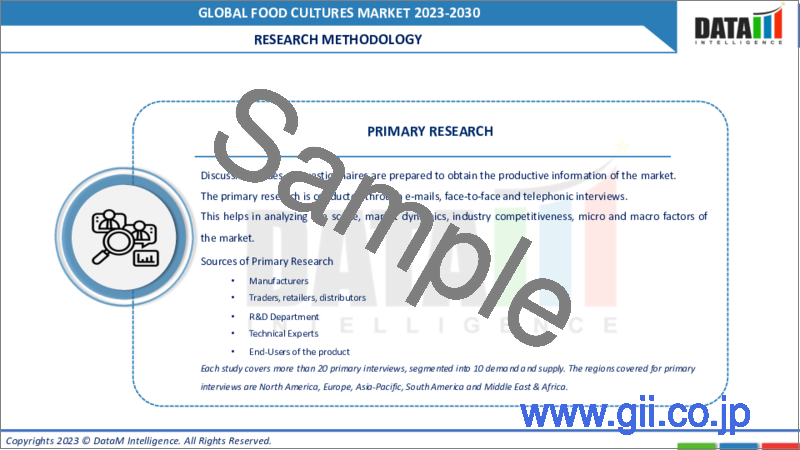|
|
市場調査レポート
商品コード
1372579
世界の食品培養市場-2023年~2030年Global Food Cultures Market - 2023-2030 |
||||||
カスタマイズ可能
適宜更新あり
|
|||||||
| 世界の食品培養市場-2023年~2030年 |
|
出版日: 2023年10月18日
発行: DataM Intelligence
ページ情報: 英文 186 Pages
納期: 即日から翌営業日
|
- 全表示
- 概要
- 目次
概要
世界の食品培養物市場は2022年に17億米ドルに達し、2023-2030年の予測期間中にCAGR 6.8%で成長し、2030年には28億米ドルに達すると予測されています。
テクノロジーの台頭が世界の食文化市場を牽引しています。オンライン・フード・デリバリー・サービス、フード・ブログ、ソーシャル・メディア・プラットフォームは、消費者が食品を発見し、注文することに変革をもたらし、食品動向への関心の高まりにつながっています。消費者には菜食主義、グルテンフリー、ケト食など、食事の嗜好や制限があります。食品会社は、こうした個々の嗜好に対応した幅広い製品を提供しています。
北米は、健康とウェルネスへの関心が高まりつつある多様で重要な消費者基盤を有しており、プロバイオティクスや発酵を含む食品培養物を組み込んだ食品への需要が高まっており、これが市場の成長を後押ししています。この地域の食品メーカーは、より健康的な製品を求める消費者の嗜好を満たす上で、食品培養の可能性をいち早く認識しています。
例えば、2022年2月23日、カッテージチーズに革命を起こしたとされるクリーンラベルの培養食品ブランド、グッドカルチャーは、シリーズC資金調達で6,400万米ドルの資金調達を完了したと発表しました。この資金調達ラウンドはManna Treeが主導し、SEMCAP Food &Nutritionと同ブランドのスーパーファンである有名投資家クリステン・ベルが参加しました。
ダイナミクス
健康とウェルネスに対する意識の高まり
健康とウェルネスを優先する消費者が増えるにつれ、より健康的で栄養価の高い食品への嗜好の変化が見られ、メーカーがこうした嗜好に沿った製品を開発・販売促進しているため、食品文化市場に影響を与えています。健康とウェルネスの動向は世界の広がりを見せており、フードカルチャー企業は、より健康的な食品オプションに対する世界の需要の高まりに対応するため、市場でのプレゼンスを国際的に拡大しています。
例えば、2023年9月19日、栄養、健康、美容の分野で有名な世界的企業であるDsm-Firmenich社は、非常にマイルドなヨーグルトを作るために調整されたスターター培養物の革新的なラインであるDelvoFresh Pioneerを発売しました。これらの培養液は、製造中および製品の保存期間中、卓越したpH安定性を提供し、高級素材と長期間持続する一貫したマイルドな風味を求めるヨーグルトメーカーの要求に効果的に応えます。
食品培養の世界化の進展
世界化によって料理の伝統と嗜好が混在するようになり、その結果、消費者の嗜好が多様化し、食品培養市場が幅広い嗜好と食生活の嗜好に対応する機会がもたらされ、それによって市場の成長が拡大します。食文化企業は、自社製品を市場に拡大することによって、さまざまな料理に対する世界の関心を活用しています。各社は料理の伝統に合うように自社の文化を適合させ、市場での存在感を高めています。
グローバリゼーションは、さまざまな料理の伝統の要素を融合させたフュージョン料理へと向かっています。食文化はこうしたフュージョン製品の創造に利用され、ユニークで文化的に多様な食体験を求める消費者に対応しています。消費者が世界の料理を探求するにつれて、本物の味と伝統的な調理法に対する需要が高まっています。食文化はさまざまな地域の培養食品の信憑性を確保し、それによって市場の需要を牽引しています。
サプライ・チェーン課題の高まり
必要不可欠な原材料の入手の遅れや生産工程の中断といったサプライ・チェーンの課題は、食品培養のタイムリーな生産を妨げる可能性があります。その結果、市場で品不足が発生し、食品メーカーに不確実性をもたらす可能性があります。サプライ・チェーンの混乱は、しばしば原材料の輸送、保管、調達のコスト増につながり、メーカーは市場での製品の値ごろ感を低下させる可能性があります。
サプライ・チェーンの課題は、研究開発努力から資源と注意をそらす可能性があります。フード・カルチャー企業は、サプライ・チェーンの問題に対処するためにより多くの資源を割り当てなければならず、その結果、新製品を革新して市場に投入する能力が制限されます。サプライ・チェーンの混乱は市場に不確実性をもたらし、食品培養企業は生産と流通の計画と予測を困難にし、市場の安定性を低下させる。
価格変動の増大
食品培養物の生産に使用される主な成分や原材料の価格変動は、メーカーにコストの不確実性をもたらし、予算編成や財務計画に課題をもたらし、研究開発や市場開拓への投資能力に影響を及ぼす可能性があります。メーカーは、収益性に影響しうるこうしたコスト増を吸収し、顧客に転嫁することで、製品の市場競争力を低下させる可能性があります。
価格変動は消費者の価格感応度を高める。消費者はより低価格の代替品を求め、食文化に大きく依存する製品の消費を減らすため、市場全体の需要に影響を与える可能性があります。価格変動のある市場では、各社が市場シェアの維持・拡大を競い合うため、競争が激化する可能性があります。この競争は利益率を圧迫し、食品培養企業が健全な収益性を維持することを困難にします。
目次
第1章 調査手法と調査範囲
第2章 定義と概要
第3章 エグゼクティブサマリー
第4章 市場力学
- 影響要因
- 促進要因
- 健康とウェルネスに対する意識の高まり
- 食文化の世界化の進展
- 抑制要因
- サプライチェーンの課題増加
- 価格変動の増大
- 機会
- 影響分析
- 促進要因
第5章 産業分析
- ポーターのファイブフォース分析
- サプライチェーン分析
- 価格分析
- 規制分析
- ロシア・ウクライナ戦争の影響分析
- DMI意見
第6章 COVID-19分析
第7章 微生物タイプ別
- 細菌
- 酵母
- カビ
第8章 製品タイプ別
- スターター培養物
- 保護培養
- プロバイオティック培養物
第9章 機能別
- テクスチャライザー
- 香料
- 保存料
- 着色料
- その他
第10章 用途別
- 乳製品
- 肉・魚介類
- 飲料
- その他
第11章 地域別
- 北米
- 米国
- カナダ
- メキシコ
- 欧州
- ドイツ
- 英国
- フランス
- イタリア
- ロシア
- その他欧州
- 南米
- ブラジル
- アルゼンチン
- その他南米
- アジア太平洋
- 中国
- インド
- 日本
- オーストラリア
- その他アジア太平洋地域
- 中東・アフリカ
第12章 競合情勢
- 競合シナリオ
- 市況/シェア分析
- M&A分析
第13章 企業プロファイル
- Kerry Group PLC
- 会社概要
- 製品ポートフォリオと説明
- 財務概要
- 主な発展
- Koninklijke DSM NV
- DuPont de Nemours, Inc.
- Corbion NV
- Cargill, Incorporated
- Lallemand Inc.
- CSK Food Enrichment USA Inc.
- Chr. Hansen Holding A/S
- International Flavors & Fragrances Inc.
第14章 付録
Overview
Global Food Cultures Market reached US$ 1.7 billion in 2022 and is expected to reach US$ 2.8 billion by 2030, growing with a CAGR of 6.8% during the forecast period 2023-2030.
The rise of technology is driving the global food cultures market. Online food delivery services, food blogging, and social media platforms are transforming consumers to discover, and order food leading to an increased interest in food trends. Consumers have dietary preferences and restrictions, such as veganism, gluten-free, and keto diets. Food companies are offering a wider range of products that cater to these individual preferences.
North America has a significant and diverse consumer base with a growing interest in health and wellness is increasing the demand for food products that incorporate food cultures including probiotics and fermentation, which is propelling the growth of the market. Food manufacturers in the region are quick to recognize the potential of food cultures in meeting consumer preferences for healthier products.
For instance, on February 23, 2022, Good Culture, the clean-label cultured foods brand credited with revolutionizing cottage cheese, announced the completion of $64 million fund in Series C funding. The funding round was led by Manna Tree, with participation from SEMCAP Food & Nutrition and celebrity investor Kristen Bell, a superfan of the brand.
Dynamics
Growing Emphasis on Health and Wellness Awareness
As more consumers prioritize health and wellness, there is a shift in their preferences toward healthier and more nutritious foods is influencing the food cultures market as manufacturers are developing and promoting products that align with these preferences. The health and wellness trend is a global expansion prompting food culture companies to expand their market presence internationally to cater to the growing demand for healthier food options worldwide.
For instance, on September 19, 2023, Dsm-Firmenich, a renowned global player in the fields of nutrition, health, and beauty, launched DelvoFresh Pioneer, an innovative line of starter cultures tailored for the creation of exceptionally mild yogurts. These cultures offer remarkable pH stability during production and throughout the product's shelf life, effectively meeting the demands of yogurt manufacturers for premium ingredients and a consistently mild flavor that endures over time.
Increasing Globalization of Food Culture
Globalization is leading to a mixing of culinary traditions and tastes, resulting in diverse consumer preferences presenting opportunities for the food cultures market to cater to a wide range of tastes and dietary preferences, thereby expanding its market growth. Food culture companies are capitalizing on the global interest in different cuisines by expanding their products to markets. They are adapting their cultures to suit culinary traditions, broadening their market presence.
Globalization is rising to fusion foods that blend elements from various culinary traditions. Food cultures are used to create these fusion products, catering to consumers who seek unique and culturally diverse dining experiences. As consumers explore global cuisines, there is a growing demand for authentic flavors and traditional food preparation methods. Food cultures are ensuring the authenticity of cultured foods from different regions, thereby driving their market demand.
Rising Supply Chain Challenges
Supply chain challenges, such as delays in the availability of essential ingredients and disruptions in production processes, can hinder the timely production of food cultures. This can result in shortages in the market, leading to uncertainty for food manufacturers. Supply chain disruptions often lead to increased costs for transportation, storage, and procurement of raw materials and manufacturers potentially reducing the affordability of their products in the market.
Supply chain challenges can divert resources and attention away from research and development efforts. Food cultures companies have to allocate more resources to address supply chain issues, limiting their ability to innovate and introduce new products to the market. Supply chain disruptions can create uncertainty in the market, making it difficult for food cultures companies to plan and forecast their production and distribution and reducing market stability.
Increasing Price Fluctuations
Price fluctuations in key ingredients and raw materials used in food cultures production can create cost uncertainty for manufacturers leading to challenges in budgeting and financial planning, potentially impacting their ability to invest in research and development and expand their market presence. Manufacturers absorb these increased costs, which can affect profitability, and pass them on to customers, potentially making their products less competitive in the market.
Price fluctuations can make consumers more price-sensitive. They seek lower-priced alternatives and reduce their consumption of products that rely heavily on food cultures, which can impact overall market demand. In a market with price fluctuations, competition can intensify as companies vie to maintain and gain market share. This competition can put pressure on profit margins, making it difficult for food cultures companies to maintain healthy profitability.
Segment Analysis
The global food cultures market is segmented based on microorganism type, product type, function and application, and region.
Wide Application Range of Starter Cultures in the Dairy Industry
Starter cultures are versatile and find application in various food and beverage products and are contributing to segment dominance in the market. The dairy industry, in particular, relies heavily on starter cultures. Yogurt, cheese, and other dairy products require specific strains of bacteria to initiate fermentation, making the starter cultures segment a substantial part of the overall food cultures market.
Starter cultures play a pivotal role in ensuring consistency and quality in fermented food products. Food manufacturers prioritize these attributes to meet consumer expectations, making starter cultures a crucial element of the market. Advancements in biotechnology and microbiology are leading to the development of specialized starter cultures. These innovations cater to the specific needs of food manufacturers, enhancing the attractiveness of the segment in the market.
Geographical Penetration
Wide Consumer Base and Health and Wellness Trends in North America
North America is dominating the global food cultures market. The region had a substantial and diverse consumer base with a strong appetite for food products that incorporate food cultures. The region boasts an advanced and sophisticated food and beverage industry. Food manufacturers in the region are recognizing the potential of food cultures in meeting consumer preferences for healthier and more natural products, which is significantly bolstering the market.
The health and wellness trend is a market-impacting force in the region, with consumers seeking products that support gut health, immunity, and overall well-being. Food cultures, known for their probiotic properties, are perfectly aligned with these trends, further supporting their adoption in the market. North America is witnessing extensive innovation in the development of new food products that incorporate food cultures coupled with a wide range of products and is propelling market growth.
COVID-19 Impact Analysis:
The pandemic disrupted global supply chains and has affected the availability of ingredients and raw materials. Food cultures production was impacted, which has led to delays and shortages in the market. Restaurant closures and reduced food service operations led to a decline in demand for food cultures used in commercial food preparation, negatively impacting the market.
However, the pandemic heightened awareness of health and wellness and has led to increased demand for immune-boosting products. Probiotic-rich foods, which often rely on food cultures, saw a surge in demand, which has positively impacted the market. Lockdowns and restaurant closures prompted a surge in home cooking. As people experimented with making their own fermented foods and sourdough bread, there was a boost in demand for food cultures for homemade applications.
Russia-Ukraine War Impact Analysis
The conflict disrupted supply chains, especially as Ukraine, a major supplier of grains and dairy products, faced challenges in production and export. This led to shortages of key ingredients, impacting production capacity and market availability. Supply disruptions led to price volatility for agricultural commodities and ingredients used in food cultures. Fluctuating prices affected production costs, which, in turn, impacted product pricing in the market.
Geopolitical tensions created uncertainty in international trade and diplomatic relations. Food cultures companies involved in global trade faced challenges related to trade restrictions and tariffs, affecting their market strategies and competitiveness. The conflict had varying regional impacts on the food cultures market. Regions closer to the conflict experienced more significant disruptions in supply chains and trade, which affected local markets.
By Microorganism Type
- Bacteria
- Yeast
- Mold
By Product Type
- Starter Cultures
- Protective Cultures
- Probiotic Cultures
By Function
- Texturizer
- Flavorant
- Preservative
- Colorant
- Others
By Application
- Dairy Products
- Meat & Seafood
- Beverages
- Others
By Region
- North America
- U.S.
- Canada
- Mexico
- Europe
- Germany
- UK
- France
- Italy
- Russia
- Rest of Europe
- South America
- Brazil
- Argentina
- Rest of South America
- Asia-Pacific
- China
- India
- Japan
- Australia
- Rest of Asia-Pacific
- Middle East and Africa
Key Developments
- On July 2, 2023, a Chennai-based chef initiated a global community for food and culture enthusiasts known as Dear Food. It served as a learning platform for subjects like food and culture. They built a thriving community of food enthusiasts, professionals, experts, and mentors, offering exclusive access to like-minded individuals around the world.
- On April 28, 2021, Chr. Hansen introduced the latest iteration of FreshQ food cultures, designed to enhance the bioprotective qualities of dairy product fermentation. This range of food cultures is engineered to improve freshness by competitively inhibiting the growth of yeast and mold spoilage, ensuring they are outcompeted for essential space and nutrients during the fermentation process.
- On September 6, 2020, DuPont Nutrition & Biosciences (DuPont) introduced its newest line of dairy cultures and probiotic formulations tailored for the Chinese market. The latest cultures in this series facilitate quicker fermentation and deliver higher probiotic counts, all while preserving a gentle flavor profile and delivering a premium texture that appeals to consumers.
Competitive Landscape
The major global players in the apricot oil market include Kerry Group PLC, Koninklijke DSM NV, DuPont de Nemours, Inc., Corbion NV, Cargill, Incorporated, Lallemand Inc., CSK Food Enrichment USA Inc., Chr. Hansen Holding A/S and International Flavors & Fragrances Inc.
Why Purchase the Report?
- To visualize the global food cultures market segmentation based on microorganism type, product type, function and application, and region, as well as understand critical commercial assets and players.
- Identify commercial opportunities by analyzing trends and co-development.
- Excel data sheet with numerous food cultures market-level data points with all segments.
- PDF report consists of a comprehensive analysis after exhaustive qualitative interviews and an in-depth study.
- Product mapping available as excel consisting of critical products of all the major players.
The global food cultures market report would provide approximately 58 tables, 58 figures, and 186 Pages.
Target Audience 2023
- Manufacturers/ Buyers
- Industry Investors/Investment Bankers
- Research Professionals
- Emerging Companies
Table of Contents
1. Methodology and Scope
- 1.1. Research Methodology
- 1.2. Research Objective and Scope of the Report
2. Definition and Overview
3. Executive Summary
- 3.1. Snippet by Microorganism Type
- 3.2. Snippet by Product Type
- 3.3. Snippet by Function
- 3.4. Snippet by Application
- 3.5. Snippet by Region
4. Dynamics
- 4.1. Impacting Factors
- 4.1.1. Drivers
- 4.1.1.1. Growing Emphasis on Health and Wellness Awareness
- 4.1.1.2. Increasing Globalization of Food Culture
- 4.1.2. Restraints
- 4.1.2.1. Rising Supply Chain Challenges
- 4.1.2.2. Increasing Price Fluctuations
- 4.1.3. Opportunity
- 4.1.4. Impact Analysis
- 4.1.1. Drivers
5. Industry Analysis
- 5.1. Porter's Five Force Analysis
- 5.2. Supply Chain Analysis
- 5.3. Pricing Analysis
- 5.4. Regulatory Analysis
- 5.5. Russia-Ukraine War Impact Analysis
- 5.6. DMI Opinion
6. COVID-19 Analysis
- 6.1. Analysis of COVID-19
- 6.1.1. Scenario Before COVID
- 6.1.2. Scenario During COVID
- 6.1.3. Scenario Post COVID
- 6.2. Pricing Dynamics Amid COVID-19
- 6.3. Demand-Supply Spectrum
- 6.4. Government Initiatives Related to the Market During Pandemic
- 6.5. Manufacturers Strategic Initiatives
- 6.6. Conclusion
7. By Microorganism Type
- 7.1. Introduction
- 7.1.1. Market Size Analysis and Y-o-Y Growth Analysis (%), By Microorganism Type
- 7.1.2. Market Attractiveness Index, By Microorganism Type
- 7.2. Bacteria*
- 7.2.1. Introduction
- 7.2.2. Market Size Analysis and Y-o-Y Growth Analysis (%)
- 7.3. Yeast
- 7.4. Mold
8. By Product Type
- 8.1. Introduction
- 8.1.1. Market Size Analysis and Y-o-Y Growth Analysis (%), By Product Type
- 8.1.2. Market Attractiveness Index, By Product Type
- 8.2. Starter Cultures*
- 8.2.1. Introduction
- 8.2.2. Market Size Analysis and Y-o-Y Growth Analysis (%)
- 8.3. Protective Cultures
- 8.4. Probiotic Cultures
9. By Function
- 9.1. Introduction
- 9.1.1. Market Size Analysis and Y-o-Y Growth Analysis (%), By Function
- 9.1.2. Market Attractiveness Index, By Function
- 9.2. Texturizer*
- 9.2.1. Introduction
- 9.2.2. Market Size Analysis and Y-o-Y Growth Analysis (%)
- 9.3. Flavorant
- 9.4. Preservative
- 9.5. Colorant
- 9.6. Others
10. By Application
- 10.1. Introduction
- 10.1.1. Market Size Analysis and Y-o-Y Growth Analysis (%), By Application
- 10.1.2. Market Attractiveness Index, By Application
- 10.2. Dairy Products*
- 10.2.1. Introduction
- 10.2.2. Market Size Analysis and Y-o-Y Growth Analysis (%)
- 10.3. Meat & Seafood
- 10.4. Beverages
- 10.5. Others
11. By Region
- 11.1. Introduction
- 11.1.1. Market Size Analysis and Y-o-Y Growth Analysis (%), By Region
- 11.1.2. Market Attractiveness Index, By Region
- 11.2. North America
- 11.2.1. Introduction
- 11.2.2. Key Region-Specific Dynamics
- 11.2.3. Market Size Analysis and Y-o-Y Growth Analysis (%), By Microorganism Type
- 11.2.4. Market Size Analysis and Y-o-Y Growth Analysis (%), By Product Type
- 11.2.5. Market Size Analysis and Y-o-Y Growth Analysis (%), By Function
- 11.2.6. Market Size Analysis and Y-o-Y Growth Analysis (%), By Application
- 11.2.7. Market Size Analysis and Y-o-Y Growth Analysis (%), By Country
- 11.2.7.1. U.S.
- 11.2.7.2. Canada
- 11.2.7.3. Mexico
- 11.3. Europe
- 11.3.1. Introduction
- 11.3.2. Key Region-Specific Dynamics
- 11.3.3. Market Size Analysis and Y-o-Y Growth Analysis (%), By Microorganism Type
- 11.3.4. Market Size Analysis and Y-o-Y Growth Analysis (%), By Product Type
- 11.3.5. Market Size Analysis and Y-o-Y Growth Analysis (%), By Function
- 11.3.6. Market Size Analysis and Y-o-Y Growth Analysis (%), By Application
- 11.3.7. Market Size Analysis and Y-o-Y Growth Analysis (%), By Country
- 11.3.7.1. Germany
- 11.3.7.2. UK
- 11.3.7.3. France
- 11.3.7.4. Italy
- 11.3.7.5. Russia
- 11.3.7.6. Rest of Europe
- 11.4. South America
- 11.4.1. Introduction
- 11.4.2. Key Region-Specific Dynamics
- 11.4.3. Market Size Analysis and Y-o-Y Growth Analysis (%), By Microorganism Type
- 11.4.4. Market Size Analysis and Y-o-Y Growth Analysis (%), By Product Type
- 11.4.5. Market Size Analysis and Y-o-Y Growth Analysis (%), By Function
- 11.4.6. Market Size Analysis and Y-o-Y Growth Analysis (%), By Application
- 11.4.7. Market Size Analysis and Y-o-Y Growth Analysis (%), By Country
- 11.4.7.1. Brazil
- 11.4.7.2. Argentina
- 11.4.7.3. Rest of South America
- 11.5. Asia-Pacific
- 11.5.1. Introduction
- 11.5.2. Key Region-Specific Dynamics
- 11.5.3. Market Size Analysis and Y-o-Y Growth Analysis (%), By Microorganism Type
- 11.5.4. Market Size Analysis and Y-o-Y Growth Analysis (%), By Product Type
- 11.5.5. Market Size Analysis and Y-o-Y Growth Analysis (%), By Function
- 11.5.6. Market Size Analysis and Y-o-Y Growth Analysis (%), By Application
- 11.5.7. Market Size Analysis and Y-o-Y Growth Analysis (%), By Country
- 11.5.7.1. China
- 11.5.7.2. India
- 11.5.7.3. Japan
- 11.5.7.4. Australia
- 11.5.7.5. Rest of Asia-Pacific
- 11.6. Middle East and Africa
- 11.6.1. Introduction
- 11.6.2. Key Region-Specific Dynamics
- 11.6.3. Market Size Analysis and Y-o-Y Growth Analysis (%), By Microorganism Type
- 11.6.4. Market Size Analysis and Y-o-Y Growth Analysis (%), By Product Type
- 11.6.5. Market Size Analysis and Y-o-Y Growth Analysis (%), By Function
- 11.6.6. Market Size Analysis and Y-o-Y Growth Analysis (%), By Application
12. Competitive Landscape
- 12.1. Competitive Scenario
- 12.2. Market Positioning/Share Analysis
- 12.3. Mergers and Acquisitions Analysis
13. Company Profiles
- 13.1. Kerry Group PLC*
- 13.1.1. Company Overview
- 13.1.2. Product Portfolio and Description
- 13.1.3. Financial Overview
- 13.1.4. Key Developments
- 13.2. Koninklijke DSM NV
- 13.3. DuPont de Nemours, Inc.
- 13.4. Corbion NV
- 13.5. Cargill, Incorporated
- 13.6. Lallemand Inc.
- 13.7. CSK Food Enrichment USA Inc.
- 13.8. Chr. Hansen Holding A/S
- 13.9. International Flavors & Fragrances Inc.
LIST NOT EXHAUSTIVE
14. Appendix
- 14.1. About Us and Services
- 14.2. Contact Us






